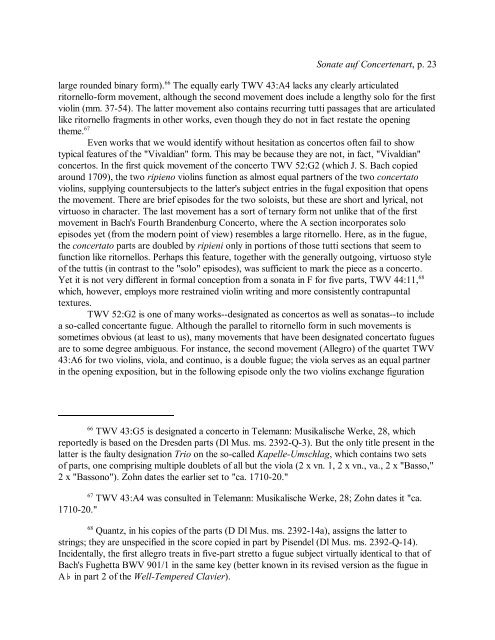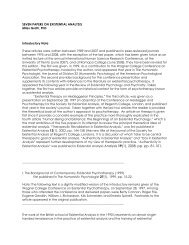The Sonate auf Concertenart: A Postmodern Invention? David ...
The Sonate auf Concertenart: A Postmodern Invention? David ...
The Sonate auf Concertenart: A Postmodern Invention? David ...
Create successful ePaper yourself
Turn your PDF publications into a flip-book with our unique Google optimized e-Paper software.
<strong>Sonate</strong> <strong>auf</strong> <strong>Concertenart</strong>, p. 23<br />
large rounded binary form). <strong>The</strong> equally early TWV 43:A4 lacks any clearly articulated<br />
66<br />
ritornello-form movement, although the second movement does include a lengthy solo for the first<br />
violin (mm. 37-54). <strong>The</strong> latter movement also contains recurring tutti passages that are articulated<br />
like ritornello fragments in other works, even though they do not in fact restate the opening<br />
theme. 67<br />
Even works that we would identify without hesitation as concertos often fail to show<br />
typical features of the "Vivaldian" form. This may be because they are not, in fact, "Vivaldian"<br />
concertos. In the first quick movement of the concerto TWV 52:G2 (which J. S. Bach copied<br />
around 1709), the two ripieno violins function as almost equal partners of the two concertato<br />
violins, supplying countersubjects to the latter's subject entries in the fugal exposition that opens<br />
the movement. <strong>The</strong>re are brief episodes for the two soloists, but these are short and lyrical, not<br />
virtuoso in character. <strong>The</strong> last movement has a sort of ternary form not unlike that of the first<br />
movement in Bach's Fourth Brandenburg Concerto, where the A section incorporates solo<br />
episodes yet (from the modern point of view) resembles a large ritornello. Here, as in the fugue,<br />
the concertato parts are doubled by ripieni only in portions of those tutti sections that seem to<br />
function like ritornellos. Perhaps this feature, together with the generally outgoing, virtuoso style<br />
of the tuttis (in contrast to the "solo" episodes), was sufficient to mark the piece as a concerto.<br />
Yet it is not very different in formal conception from a sonata in F for five parts, TWV 44:11, 68<br />
which, however, employs more restrained violin writing and more consistently contrapuntal<br />
textures.<br />
TWV 52:G2 is one of many works--designated as concertos as well as sonatas--to include<br />
a so-called concertante fugue. Although the parallel to ritornello form in such movements is<br />
sometimes obvious (at least to us), many movements that have been designated concertato fugues<br />
are to some degree ambiguous. For instance, the second movement (Allegro) of the quartet TWV<br />
43:A6 for two violins, viola, and continuo, is a double fugue; the viola serves as an equal partner<br />
in the opening exposition, but in the following episode only the two violins exchange figuration<br />
66<br />
TWV 43:G5 is designated a concerto in Telemann: Musikalische Werke, 28, which<br />
reportedly is based on the Dresden parts (Dl Mus. ms. 2392-Q-3). But the only title present in the<br />
latter is the faulty designation Trio on the so-called Kapelle-Umschlag, which contains two sets<br />
of parts, one comprising multiple doublets of all but the viola (2 x vn. 1, 2 x vn., va., 2 x "Basso,"<br />
2 x "Bassono"). Zohn dates the earlier set to "ca. 1710-20."<br />
67<br />
TWV 43:A4 was consulted in Telemann: Musikalische Werke, 28; Zohn dates it "ca.<br />
1710-20."<br />
68<br />
Quantz, in his copies of the parts (D Dl Mus. ms. 2392-14a), assigns the latter to<br />
strings; they are unspecified in the score copied in part by Pisendel (Dl Mus. ms. 2392-Q-14).<br />
Incidentally, the first allegro treats in five-part stretto a fugue subject virtually identical to that of<br />
Bach's Fughetta BWV 901/1 in the same key (better known in its revised version as the fugue in<br />
A� in part 2 of the Well-Tempered Clavier).















